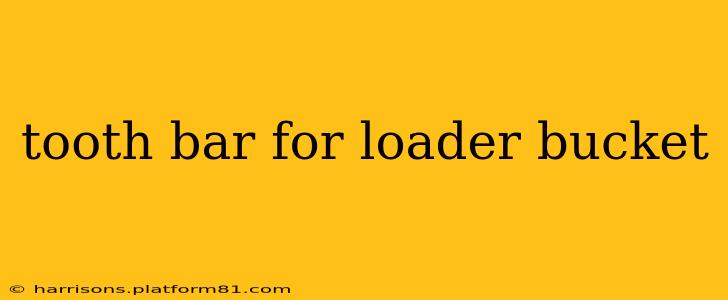A tooth bar significantly enhances the performance and durability of your loader bucket, making it ideal for demanding applications requiring increased digging and breakout force. This guide delves into the specifics of tooth bars, exploring their benefits, types, selection considerations, and maintenance.
What is a Tooth Bar for a Loader Bucket?
A tooth bar is a robust steel attachment welded or bolted onto the cutting edge of a loader bucket. It features multiple hardened teeth strategically positioned to maximize penetration and material handling capabilities. These teeth, often replaceable, provide exceptional wear resistance and significantly extend the lifespan of the bucket's cutting edge. The tooth bar itself acts as a protective barrier, absorbing much of the impact during digging and loading operations, preventing damage to the main bucket structure.
What are the Benefits of Using a Tooth Bar?
The advantages of incorporating a tooth bar on your loader bucket are numerous:
- Increased Digging Force: The teeth provide superior bite and penetration, allowing you to break through tougher materials with greater ease.
- Enhanced Breakout Force: The reinforced cutting edge and strategically placed teeth boost the overall breakout force, improving efficiency in material handling tasks.
- Extended Bucket Lifespan: By absorbing much of the impact, the tooth bar protects the main bucket structure, reducing wear and tear and extending its operational life.
- Improved Productivity: The combination of increased digging and breakout force leads to faster cycle times and significantly improved overall productivity.
- Better Material Handling: The teeth effectively grip and retain materials, minimizing spillage and improving handling efficiency.
- Enhanced Durability: The tooth bar's robust construction resists damage from impacts and abrasive materials.
What Types of Tooth Bars are Available?
Various tooth bar designs cater to different applications and material types:
- Bolt-on Tooth Bars: These are easily attached and removed, allowing for quick replacement of worn teeth or adapting the bucket to different applications.
- Weld-on Tooth Bars: Offering a more permanent solution, weld-on tooth bars provide superior strength and are favored for heavy-duty applications.
- Different Tooth Configurations: Tooth bars come with varying tooth sizes, shapes, and spacing, allowing customization for different material types and digging conditions. For example, wider spacing might be preferred for loose materials, while closer spacing might be better for compact materials.
How to Choose the Right Tooth Bar for Your Loader Bucket?
Selecting the appropriate tooth bar requires consideration of several factors:
- Loader Size and Capacity: The tooth bar must be compatible with the size and capacity of your loader bucket.
- Material Type: The type of material you'll be handling (e.g., rock, soil, gravel) significantly influences the required tooth design and material.
- Application: The intensity and nature of the application (e.g., light digging, heavy excavation) determine the necessary strength and durability of the tooth bar.
- Budget: Various tooth bar options cater to different budgets, offering a balance between performance and cost.
How to Maintain a Tooth Bar?
Regular maintenance extends the lifespan of your tooth bar and ensures optimal performance:
- Regular Inspection: Inspect the teeth and bar for wear and damage after each use.
- Tooth Replacement: Replace worn or damaged teeth promptly to maintain digging efficiency and prevent further damage.
- Lubrication: While not always necessary, some tooth bars might benefit from lubrication to reduce friction and wear.
- Proper Storage: Store the bucket and tooth bar appropriately to prevent damage when not in use.
What are the Different Materials Used for Tooth Bars?
Tooth bars are commonly made from high-strength steel alloys designed to withstand significant wear and impact. The specific alloy chosen depends on the intended application and the abrasive nature of the materials being handled. Hard-facing materials are often used on the teeth to increase their wear resistance.
How Often Should I Replace the Teeth on My Tooth Bar?
The frequency of tooth replacement varies depending on the intensity of use and the abrasiveness of the material being handled. Regular inspection is crucial; replace teeth as soon as significant wear or damage is observed. Ignoring worn teeth can lead to inefficient operation and damage to the tooth bar itself.
Can I Weld a Tooth Bar Myself?
Welding a tooth bar requires specialized skills and equipment. Improper welding can compromise the integrity of the tooth bar and potentially lead to failure, resulting in safety hazards. Professional welding services are recommended for optimal results and safety.
This comprehensive guide provides a solid foundation for understanding tooth bars and their significance in optimizing loader bucket performance. Remember to always prioritize safety and consult with equipment specialists for expert advice tailored to your specific needs and applications.
